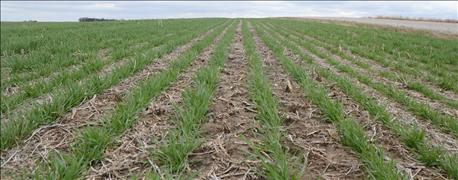Explore our blog featuring articles about farming and irrigation tips and tricks!
Now Is The Time To Start Scouting For Stripe Rust

Nebraska winter wheat is off to a good start, but stripe rust and other rust diseases are showing up in southern states.
By Tyler Harris
Nebraska’s winter wheat crop had a rough go round last year. Following severe winterkill and disease pressure from stripe rust and fusarium head blight, Nebraska saw some of the lowest total harvested bushels it’s seen in years. Last year, Nebraska wheat growers harvested just under 46 million bushels – a 25 million-bushel drop from 2014’s 71 million bushels, according to USDA National Agricultural Statistics Service data. “The wheat was just hammered by so many factors that the yield was very low,” says Stephen Wegulo, University of Nebraska professor and Extension plant pathologist.
Winter wheat off to a good start
This year, the situation is looking more promising. Most of the crop was planted on time, and while there have been concerns of winter injury or winterkill with wheat breaking dormancy earlier and premature spring growth, especially after recent freezing temperatures, Wegulo notes after a good start to the 2015-2016 growing season, much of the crop is in better shape than it was last year.
“The difference between this year and 2015 is that in the fall of last year, when the 2016 winter wheat crop was planted, we had sufficient moisture, so the germination was good compared to the fall of 2014 when it was very dry,” he says. “Because of the lack of moisture in the fall of 2014, growers didn’t get the right planting depth, germination was quite poor and wheat was very vulnerable to winterkill. Then in the winter of 2014 to 2015 we had very little snow cover. That exposed the wheat to harsh temperatures.”
Rust showing up in southern states
What may become a problem, Wegulo says, is stripe rust. Stripe rust, identifiable by yellow streaks or stripes that run parallel to the leaf, is favored by wet conditions and cooler temperatures – optimal conditions for stripe rust are around 50 to 59 degrees Fahrenheit.
With this winter’s abnormally warm temperatures, stripe rust has been active earlier than usual in southern states like Oklahoma, Texas, Arkansas, and Louisiana – there have even been reports of leaf rust and stem rust, which are favored by temperatures in the 60’s and 70’s. Recently, stripe rust and leaf rust have been confirmed in Kansas as well.
“Usually we start seeing stripe rust in Oklahoma in April, but they have been seeing it since early March,” Wegulo says. “Given what we see in the south, I think the risk is there, and growers should be prepared for stripe rust. We may see stripe rust starting in late April or mid-April.”
Stay up to date on all T-L news and get alerts on special pricing!


